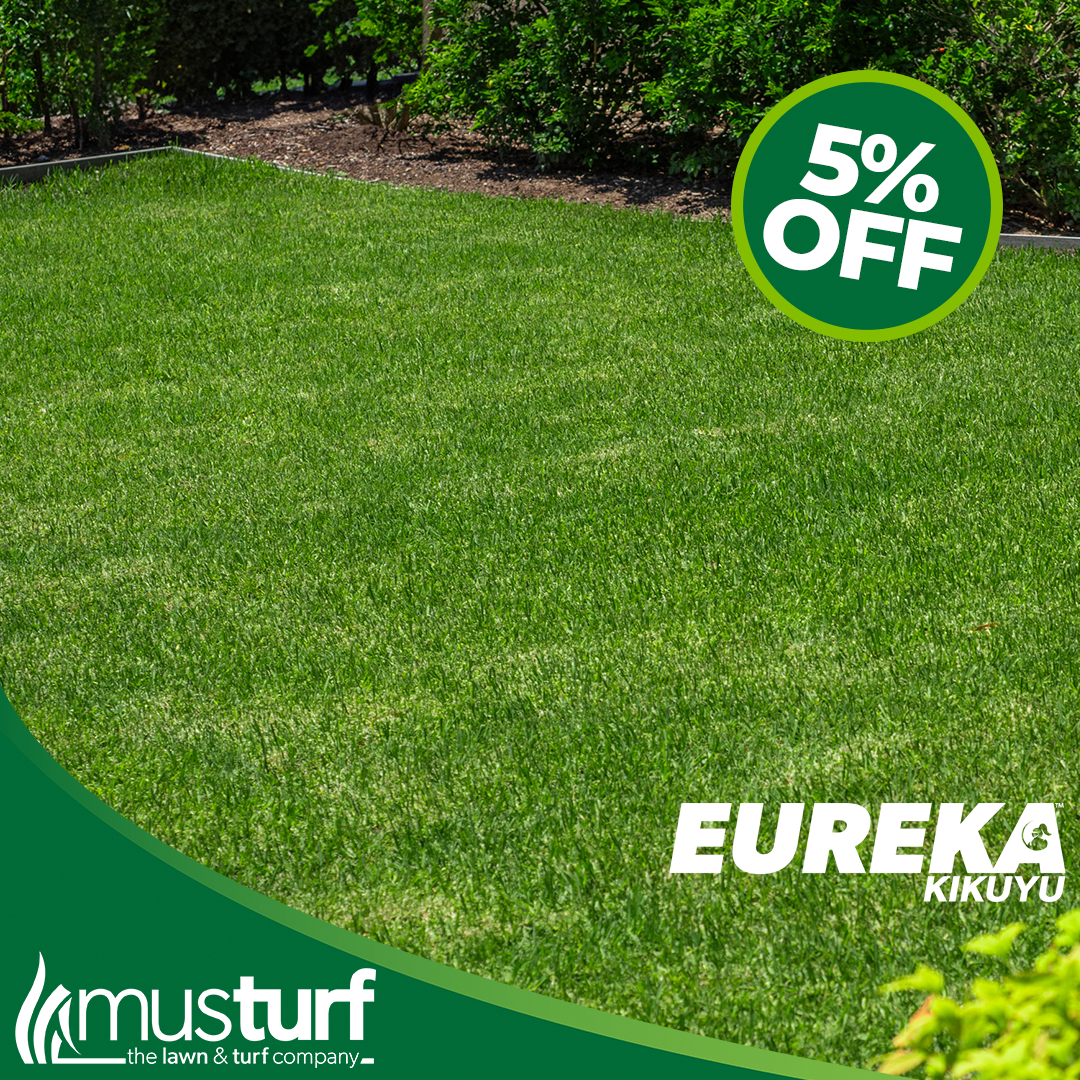Musturf
Eureka Kikuyu
Eureka Kikuyu
Eureka Kikuyu grass is a proven performer in most Australian climates. It thrives in warm-season grass regions with high temperatures and minimal water. Known for its vigorous growth habit, it is the best turf option for those needing an instant lawn solution. With a strong, deep root base, Eureka Kikuyu is exceptionally drought-tolerant and easily handles hot summers and high-traffic areas.
Eureka Kikuyu recovers rapidly due to its aggressive growth and self-repairing ability, which is ideal for home lawns, golf courses, and nature strips. Regular mowing keeps it looking lush and healthy year-round. Backed by Lawn Solutions Australia, it's a low-maintenance choice for a strong, vibrant lawn. Order now from Musturf!
Great for: Parks & gardens, Open spaces, Race courses
PER M²
Couldn't load pickup availability





-
Eureka Kikuyu Features
Eureka Kikuyu grass is a dense, rapid-growing lawn with exceptional resilience and vibrant colour year-round. As a warm season grass variety, it thrives in full sun and adapts well to various soil types, including loam, loamy sand, and sandy loam.
Eureka Kikuyu turf is non-allergenic. It's the ideal grass for home lawns, children, and pets. This makes it a perfect choice for families seeking a safe and comfortable outdoor environment. -

Shade Tolerance
Up to 25%
Wear
Very High
Maintenance
Medium
Leaf
Medium
-


-
Economical All-Rounder
Eureka Kikuyu turf is a strong-performing, economical all-rounder grass that excels in large areas like parks, gardens, and racecourses. This warm season grass variety is known for its aggressive growth habit, high drought tolerance, and ability to thrive in most Australian climates.
Clever Root System
Eureka Kikuyu grass thrives with a strong deep root base even on the hottest days. Its extensive root system supports rapid growth and self-repair, making it highly resilient. The deep root system enables it to endure frost conditions, ensuring that the turf stays lush and vibrant all year round.
10-Year Product Warranty
With every purchase of Eureka Kikuyu grass through Musturf, you’re issued with a Lawn Solutions Australia (LSA) Product Warranty Certificate and will be covered by LSA’s nationwide warranty.
-
Frequently Asked Questions
-
How Do You Treat Eureka Kikuyu Grass in the Winter?
Keeping your Eureka Kikuyu lawn healthy during winter requires a few adjustments to ensure it retains its vibrant green colour and remains strong. Lowering the mowing height slightly helps expose more of the grass to sunlight, ensuring it receives enough nutrients to sustain its health during colder months. Unlike during peak growth periods, fertilising is not recommended in winter. This rapid-growing lawn may develop uneven colour due to inconsistent sunlight absorption.
While Eureka Kikuyu turf is drought-tolerant, it still requires moderate watering in winter, but overwatering can damage its root system and impact overall lawn health. Winter can also weaken Kikuyu grass’s natural weed resistance. Early weed control is crucial to prevent unwanted growth from overtaking your home lawn.
Is Kikuyu Grass Good in Shade?
Kikuyu grass should be grown in full sun since it doesn’t thrive in shady areas. This attribute is especially important when choosing Kikuyu turf for a new lawn. You may have lots of sunlight at the beginning, but the area becomes shady as the plants grow. Over time, the shade may limit the amount of sun getting to your lawn, and the lawn will gradually start to become patchy.
Does Kikuyu Grass Die in Winter?
Eureka Kikuyu turf may become slightly discoloured with a yellowish tint during winter, yet its rapid growing lawn characteristics ensure it remains robust. To maintain your Eureka Kikuyu grass' health and vibrancy, lower the mowing height to maximise sun exposure. Provide moderate watering to support its strong deep root base. Early weed control is also necessary to prevent winter weeds from overtaking your garden beds.
Will Kikuyu Turf Take Over Weeds?
Kikuyu grass is known for its aggressive growth habit, making it more dominant than many other grass varieties. It has a natural tendency to spread rapidly, potentially overtaking other plants in your garden. Its an excellent choice for erosion control and high traffic areas. However, this means it requires regular maintenance to prevent it from encroaching other areas on your lawn.
What Is the Best Fertiliser for Kikuyu Lawn?
While Kikuyu turf doesn’t usually need fertiliser, applying nitrogen-rich fertiliser can stimulate fast growth. Well-fertilised Kikuyu lawns develop deep roots and remain strong during cold periods. It is best to use a slow-release fertiliser for your Kikuyu lawn.
How Often Should You Mow Kikuyu Lawn?
Due to its vigorous growth, Kikuyu grass needs regular mowing to maintain a lush, healthy lawn. This grass does best when mowed to a height of 3 to 4 centimetres throughout the year. During the warmer months, mow your Kikuyu lawn every 7 to 10 days to a height of 2 to 5 centimetres in areas with plenty of sunlight or light shade, or 5 to 7 centimetres in heavily shaded areas. During colder months, Kikuyu lawns require mowing every three to six weeks.












